Another Iranian Teacher Transferred To Prison To Serve His Term

Amid the chemical attacks on schools in Iran, another teacher has been transferred to prison to serve a one-year sentence.

Amid the chemical attacks on schools in Iran, another teacher has been transferred to prison to serve a one-year sentence.
Omid Shah-Mohammadi, from the city of Divandarreh in Kordestan province and a member of Kordestan Teachers Association, was reportedly transferred to Bijar prison on Saturday.
The arrest of teachers and transferring them to jail in different cities has escalated after they protested to condemn chemical attack on schools and poisoning of female students, as well as the non-payment of salaries and arrears.
Omid Shah-Mohammadi was detained along with three other teachers on June 15, 2022, for participation in the teachers' association sit-in.
They were temporarily released after 76 days of detention in Sanandaj each on a bail of 15 billion rials (30,000 USD).
Shah Mohammadi was then sentenced to five years in prison by a Revolutionary Court in Sanandaj on charge of "action against national security"; however, his term was decreased to 16 months suspended imprisonment in the Court of Appeal of Kordestan province.
Meanwhile, three other teachers in the northern province of Gilan were summoned and arrested on Saturday and sent to Lakan prison in Rasht to serve a one-year term.
On Thursday, teachers in several cities held peaceful rallies and chanted their demands including the release of Mohammad Habibi, spokesperson of Iranian Teachers Trade Association as well as their long-held grievances over paygrades and low salaries.
Teachers have threatened to stage street protests in May if their demands are not met.
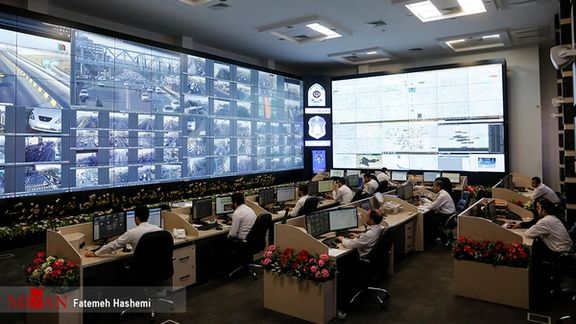
While countless Iranian women are appearing in public without hijab, the Islamic Republic is installing cameras around cities to rein in the growing act of civil disobedience.
The head of the traffic police of the capital, Tehran, said on Sunday that "cameras installed for recording traffic violations also record cases of women removing hijab.”
Second brigadier general Mohammad-Hossein Hamidi told Tasnim news agency, affiliated with the Revolutionary Guards, that "all the (surveillance) systems across the city have multi-purpose operations and store all kinds of information”.
He did not provide details about the data recorded by the cameras but said that although the surveillance cameras have been installed by the municipality, they have different data banks from which any government office or organization can extract information relevant to them.
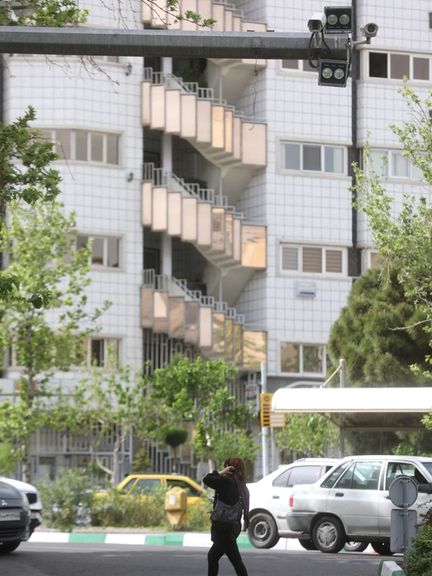
“The traffic police use the traffic data from these cameras, and other departments collect the information they need," he said, without elaborating to which institutions and organizations these departments belong.
However, last year, hacktivist group Black Reward found access to databanks of Fars News Agency, another media outlet affiliated with the IRGC. The hack revealed that the regime has begun collecting information about street protests from footage of CCTV cameras installed throughout the country.
Several lawmakers and hijab enforcement officials had talked about the use of cameras in public places and thoroughfares to identify and penalize unveiled women, but this is the first time a police commander has admitted that traffic cameras are recording other sorts of data on people.

According to a Saturday statement by the police, the move is aimed at “preventing resistance against the hijab law,” adding that such resistance against the regime’s strict Islamic dress code tarnishes Iran's “spiritual image” and spreads insecurity.
Meanwhile, Ahmad-Reza Radan, the chief commander of Iran’s police forces, said that the forces under his command will use advanced technology and equipment to identify people who do not observe the mandatory hijab in public places as of next Saturday. Women and girls who do not wear scarves in "public places, cars or commercial centers" will be prosecuted, he added.
The uprising that was sparked by the death in police custody of 22-year-old Mahsa Amini has made it increasingly difficult to enforce the mandatory Islamic dress code. Appearing in public without a full veil has become a common sight even in small and more conservative towns. Since the beginning of the ‘Women, Life, Liberty’ movement in September last year, thousands of girls and women have set fire to their headscarves in a symbolic move and voiced opposition to compulsory hijab.

Earlier in April, Iran’s ruler Ali Khamenei threw his weight behind the hardliners who have been pushing for new measures to enforce the mandatory hijab laws, saying that “hijab is a restriction based on Sharia (Islamic law) and the constitution.” Khamenei’s assertion that flouting hijab is “religiously and politically haram” has emboldened officials for stricter measures. In a bid to deter the droves of women rebelling against hijab, the regime has also embarked on public humiliation tactics, such as placing officers in Tehran subway to prevent women without the hijab from entering.
It has not only emboldened officials but triggered a wave of civilian actions as the public takes the law into their own hands, seen last week when a mother and daughter were attacked with yogurt while out shopping.
The Islamic Republic, founded in 1979, is the only Muslim country other than Taliban ruled Afghanistan with such a strict interpretation of hijab and nationwide coercive measures for its observance, while Islam is the official religion in 26 countries in Asia, sub-Saharan Africa, North Africa, and the Middle East.
On Sunday, firebrand mouthpiece of the Supreme Leader, Hossein Shariatmadari, the editor of the flagship hardliner newspaper Kayhan, compared hijabless women to "drug addicts and drug dealers" who should be "seriously dealt with”.
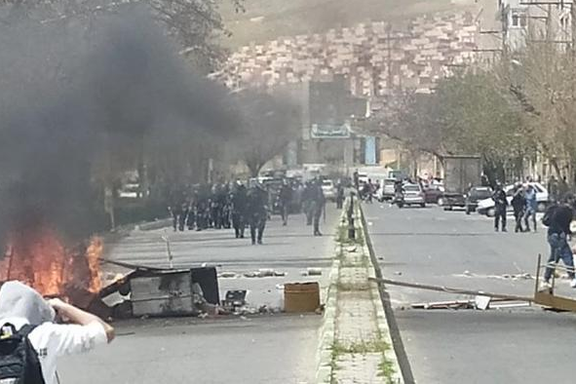
Amid intensified measures to enforce hijab laws, Iran's regime is facing a renewed wave of protests over chemical attacks on schoolgirls and economic woes.
According to videos sent to Iran International, people in the Kurdish majority city of Saqqez -- the hometown of Mahsa Amini whose death in the hands of hijab enforcers ignited the current uprising – held a rally with security forces reportedly opening fire to disperse the protesters.
Hengaw, a Norway-based rights group which monitors abuses and violations in Iran’s Kurdish regions, reported that at least six girls’ schools in Saqqez were attacked by the mysterious gas on Sunday, igniting renewed protests against the regime’s inaction or possible involvement in the poisonings. An unknown number of students were sent to hospital following the attacks.
Protesters pulled down the Islamic Republic flag from the top of a school, likely to have been one of the places targeted by the chemical attack. The situation in the city is still tense as protesters have set up bonfires on streets and scores of anti-riot forces have been dispatched throughout the city.
There are also reports of another chemical attack at a girls' school in the central city of Esfahan (Isfahan) on Sunday.
On Saturday, 12 schools were targeted in the Kurdish city of Naqadeh, the city of Orumiyeh (Urmia), the city of Ardabil, Haftkal city of southern Khuzestan province, and the city of Pardis in Tehran province. Last week on Monday and Tuesday, at least five girls’ schools were targeted across the country, with reports of hospitalizations.
The attacks coincided with the funeral of a Kurdish child from the city of Kamyaran who was laid to rest in Pashavah village in Kordestan province. The 16-year-old boy, Karo Pashabadi, had been taken to hospital for treatment on March 15 after inhaling poisonous gas after a chemical attack on a school in Tehran, where he was living. At least one other child, 11-year-old Fatemeh Razaei, has died in the attacks which began on November 30 and have taken place in hundreds of schools nationwide.
Close to 300 schools were targeted in the past Iranian year ending in March 20 without any apparent effort by the government to seriously pursue the perpetrators or explain to terrified parents and students what was happening in so many schools. Thousands of students have been affected, mostly girls, with hundreds more hospitalized with symptoms including respiratory distress, numbness in their limbs, heart palpitations, headaches, nausea, and vomiting.
Ordinary Iranians have been suspicious of the involvement of the regime itself, or religious extremists protected by the regime, calling the attacks “state terrorism,” although the regime has denied responsibility and even staged arrests of suspects after widespread protests. Popular belief is that such large-scale and coordinated attacks cannot happen without the green light of the regime’s authorities.
International reaction has demanded answers to the mystery poisonings including a spokesperson for the UN Human Rights Council in Geneva calling for a transparent investigation along with the White House, which demanded accountability for those responsible.
Decrying the attacks, several opposition figures, including Nobel Peace Prize winner and human rights lawyer Shirin Ebadi, exiled prince Reza Pahlavi have emphasized the role of the regime and urged the international community to pressure the regime to provide access for investigations on-the-ground in Iran.

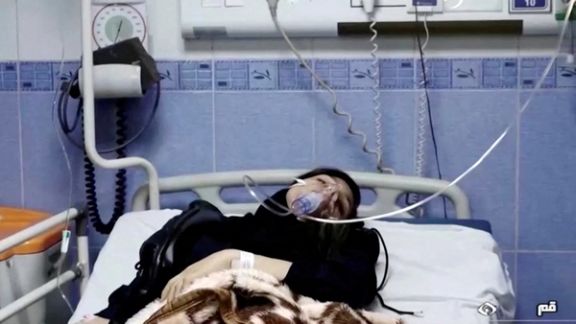
A Kurdish child from the city of Kamyaran, hospitalized after a chemical attack on a school in Tehran last month, has tragically died in hospital.
Hengaw Human Rights Organization reported Sunday that Karo Pashabadi, a 16-year-old boy living in Tehran, died three weeks after a chemical attack. The teenager was taken to hospital for treatment on March 15 after inhaling the poisonous gas used in the attack.
His body was laid to rest in Pashavah village of Kamyaran city in Kordestan Province on Saturday. At least one other child, 11-year-old Fatemeh Razaei, has died in the attacks which began on November 30 and have taken place in hundreds of schools nationwide.
Thousands of pupils have been affected, mostly girls, with hundreds more hospitalized with symptoms including respiratory distress, numbness in their limbs, heart palpitations, headaches, nausea, and vomiting.
Meanwhile, Hengaw also reported that the students of three high schools in the Kurdish city of Saqqez were poisoned and taken to medical centers on Sunday as the wave of poisonings blighting children across Iran appear to have returned after a short respite for Nowruz holidays.
Countless ordinary Iranians have been suspicious of the regime’s involvement, though the regime has denied responsibility and even staged arrests of suspects after protests against the poisonings added further fuel to the regime’s burning fire of unrest.
International reaction has demanded answers to the mystery poisonings including a spokesperson for the UN Human Rights Council in Geneva calling for a transparent investigation along with the White House, which demanded accountability for those responsible.
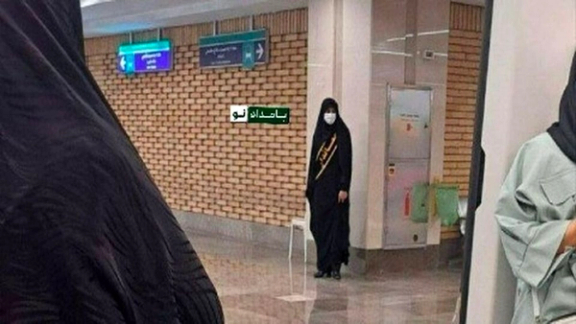
In a bid to deter the droves of women rebelling against mandatory hijab, the regime in turning to new forms of surveillance and public humiliation tactics.
Iran’s state TV published a video in which Tehran subway officers do not allow women without the mandatory hijab to enter.
After the statements by Supreme Leader Ali Khamenei about the mandatory hijab on Tuesday, a new round of the regime confrontation with those who do not want to wear hijab has begun.
Social media users have reported that some officers tasked with threatening those without hijab are stationed in metro wagons and the entries to the subway.
Meanwhile, police in Iran announced on Saturday that it is going to use "smart" technology in public places to identify and then punish women who do not wear hijab.
In a statement, police threatened that they would take action to identify those breaching the regime laws by using tools and smart cameras in public places and thoroughfares.
Islamic Republic's Police Chief Ahmad-Reza Radan confirmed in an interview with state TV: “From next Saturday, people who remove their veil will be identified by using smart equipment.”
Warnings will be issued before women are called to court.
Hundreds of women have been seen unveiled in public places since the death of Mahsa Amini in police custody for ‘improper’ wearing of her hijab. Others have been seen burning their veils in defiance, and cutting hair, in a rejection of the regime’s tough Islamic laws.
Although there is no accurate count but over the past four decades hundreds of thousands of these women have been arrested, fined, or jailed by authorities.

Three prominent actresses defiantly appeared ‘bare headed’ at the funeral of a colleague Friday despite authorities’ warnings of serious consequences for ‘hijabless’ women.
Katayoun Riahi, Golab Adineh, and Fatemeh Motamed-Aria attended the funeral of popular film director, Kiumars Pourahmad in Tehran, who tragically ended his own life earlier this week.
Angered by such open defiance, hardliners on social media are calling for their punishment to set an example for others while taking their cue from Supreme Leader Ali Khamenei’s speech earlier this week. Officials, lawmakers and regime clerics are vowing to re-impose the hijab rules that women have increasingly been defying in the past six months.
“Start from celebrities, not the hijabless girls on the street because these celebrities are their role models,” a hijab promoter said in a Twitter post with the ‘hijabless’ images of Riahi and Adineh at the funeral.
Riahi, 61, was the first among Iranian female artists to express her solidarity with the Mahsa Movement amidst the nationwide protests in September by sharing her photo without a veil on Instagram. “Iranian women are each other’s voices,” she said in her post.
A man wearing a shawl over his head at a protest rally outside the National Library
The award-winning actress fled in time to avoid being arrested by security forces who raided her house but was arrested in November after living in hiding for two months.
Riahi was subjected to huge phycological pressure during her trial in December to “apologize’ for her deed but had to be taken to hospital from the court after fainting and losing her consciousness in front of the cameras filming the proceedings, apparently for airing on the state television.
Kazem Sadighi, head of the regime’s chastity outfit, the headquarters for Promoting Virtue and Preventing Vice, said Saturday that the “hijab criteria” drawn up by his organization has been sent to the president, parliament and the judiciary and that it will be communicated to government offices to enforce after being finalized.
Katayoun Riahi telling Iran International TV in November that she had never believed in hijab to “remove” it now.
In their sermons this Friday, the ultra-hardliner Friday imam of the religious city of Mashhad, Ahmad Alamolholda, threatened again that “people” may take the matter into their own hands against women who defy the hijab if authorities did not “have plans” to deal with “hijablessness”.
Katayoun Riahi telling Iran International TV in November that she had never believed in hijab to “remove” it now.
Khamenei and other officials including Chief Justice Gholam-Hossein Mohseni Ejei have repeatedly accused those opposed to compulsory hijab of working for “enemy” intelligence services.
At a meeting with state officials Tuesday, Khamenei claimed that foreign intelligence services were encouraging Iranian women to disobey mandatory hijab. He also claimed that “the enemy” is working according to “a plan and plot” and urged authorities to have their own plan for dealing with the issue of hijablessness.
While claiming that most Iranians agree with enforcing compulsory hijab, Ejei’s deputy, Mohammad Mosaddegh, repeated Khamenei’s accusations Thursday and said the judiciary will “take serious action” against “hostile” individuals who are “cooperating with foreign intelligence services to promote hijablessness”.
The police in several cities including Tehran have been summoning women whose ‘hijabless’ images were picked up by CCTV cameras. The police have also asked citizens to report the plate numbers of cars in which passengers are ‘hijabless’ and threatened to punish them “in accordance with the law”.
The measure has backfired and caused chaos in the system as many citizens have reported the plate numbers of cars whose passengers wore hijab, particularly the long black veil known as chador that the regime has always promoted as the measure of excellence in hijab abidance.
On Friday a small group of male and female members of the National Library protested outside the library against the decision to cancel the membership of ‘hijabless’ women.
Men who had participated in the rally wore headscarves in protest to compulsory hijab and after chanting “Woman, Life, Freedom” women threw their headcovers into a fountain.